Alaska's Rusting Rivers
Air Date: Week of June 7, 2024
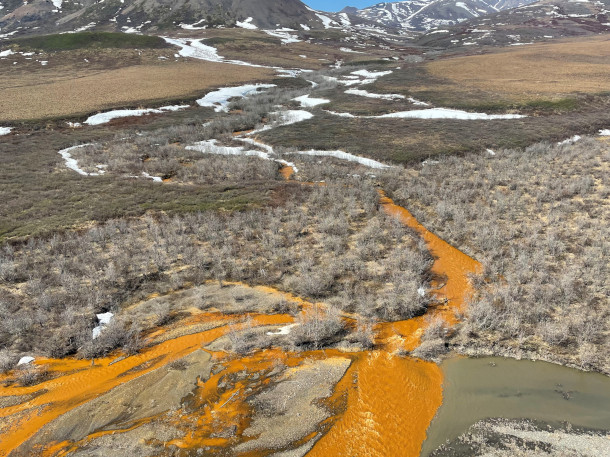
Some streams and rivers in Alaska’s remote Brooks Mountain Range are turning orange. Researchers think melting permafrost may be the culprit. (Photo: Josh Koch, U.S. Geological Survey)
Streams in northern Alaska are turning a cloudy orange, and scientists think the cause is metals like iron leaching from melting permafrost as the Arctic rapidly warms. Jon O’Donnell is an ecologist for the Arctic Inventory and Monitoring Network at the National Park Service and discusses the research and potential consequences of these changes with Host Jenni Doering.
Transcript
CURWOOD: From PRX and the Jennifer and Ted Stanley Studios at the University of Massachusetts Boston, this is Living on Earth. I’m Steve Curwood.
DOERING: And I’m Jenni Doering. The rapid climate change happening to our planet is often invisible. Think of rising carbon dioxide levels in the atmosphere, or heat waves across the globe. But in the far north of Alaska, some changes are impossible not to see. That’s because dozens of crystal-clear streams in the Brooks Range are turning a cloudy orange. A 2024 paper published in the Nature journal Communications: Earth and Environment connects the change to rapidly thawing permafrost that appears to be releasing metals like iron into these streams. Lead author Jon O’Donnell is an ecologist for the Arctic Inventory and Monitoring Network at the National Park Service, and he joins us now from Anchorage. Jon, welcome to Living on Earth!
O'DONNELL: Thanks for having me.
DOERING: So when did you first notice that the streams in Alaska's Brooks Range looked rusty? And what was your reaction?
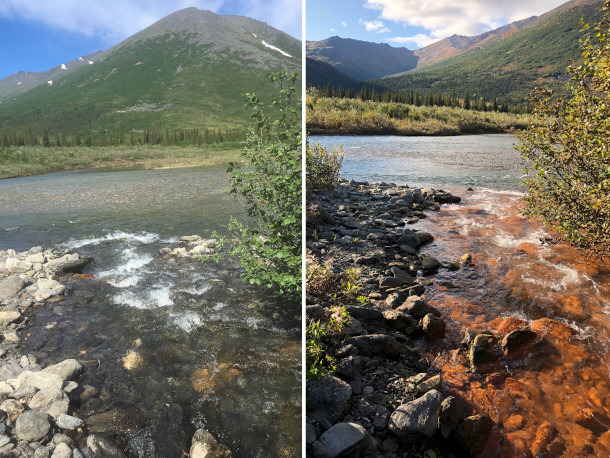
The Akillik River in 2017 (left) versus in 2018 (right), Kobuk Valley National Park, Alaska. (Photo: Jon O’Donnell/NPS)
O'DONNELL: So we were monitoring a site in Kobuk Valley National Park, on the Akillik River. And we had been collecting samples there, water samples and biological samples, like fish and bugs. That was in 2017. And when we went back in August of 2018, for a site visit, we noticed that the stream had turned orange. And this was surprising to us. And so, you know, we were accessing this site in a small helicopter. And you know, my initial thoughts were, this is kind of an important thing to document. But I kind of thought it was maybe just anomalous, or a case study, where, you know, this might just be a one-off thing, but it'd be a good story. So we should do a good job, collect all the samples that we need to collect. So we grabbed water samples, and we collected fish and bugs. And then when we went back out in 2019, we were flying around the region, and we noticed that there were more streams than we had previously noticed, had turned orange. And that was kind of when I started to think that this might be a bigger issue than this anomalous one stream in Kobuk valley, that it may be a bigger issue. And at that point, we started trying to compile observations from across the Brooks Range.
DOERING: So you mentioned that you did some water sampling. And you were finding these minerals in the water samples. What kinds of minerals have you been collecting?
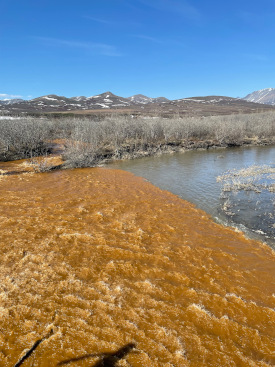
The researchers found elevated concentrations of iron, arsenic, zinc, copper, and cadmium in the orange streams. (Photo: Josh Koch, U.S. Geological Survey)
O'DONNELL: Yeah, so we collect water samples from these orange streams, and then nearby clear-water streams. And we measure the same suite of chemicals on all of them. So the orange in the stream, that is a reflection of iron. And so those are iron particulates, it makes the stream very turbid, or filled with particles. And then those particles often get deposited on the stream bed, and so they blanket the rocks and the sediments in the bottom of the stream. But in addition to the iron, we see that these orange streams are more acidic, so they have a lower pH than, than clear-water streams. And there's a whole range of trace metals that are potentially toxic, both in terms of drinking water and for life that are living in these streams. And so examples of those trace metals that we've seen are like zinc and copper, and arsenic and cadmium and a range of others that are elevated in concentration in the orange streams.
DOERING: So what do you think is going on here? What do we know about what might be causing this change in these streams and rivers?
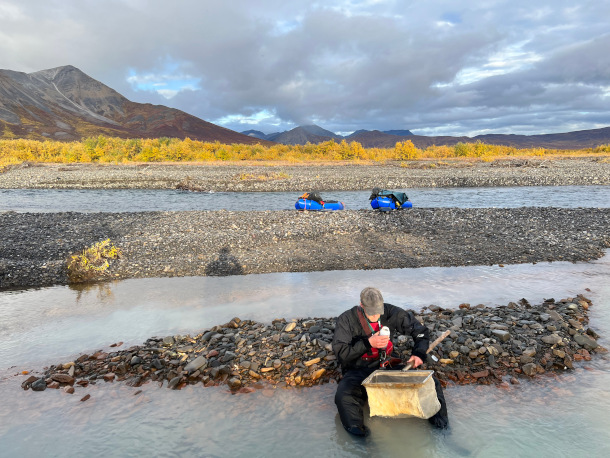
Mike Carey, Research Fish Biologist for the U.S. Geological Survey, collecting stream macroinvertebrates (bugs) on the Kugururok River, Noatak National Preserve. The researchers found a decline in bug and fish populations in the orange streams they studied. (Photo: Jon O'Donnell/NPS)
O'DONNELL: All of our observations point towards climate and permafrost thaw as a driver of this change. The reasons for that are one, the timing. So we've documented over 70 streams and rivers that have changed in the very recent past here, so in the last 10, 10 to 15 years. And this is a period of time where the climate has warmed dramatically in the Arctic. There's also evidence that in these specific watersheds, the climate has warmed past the point where permafrost can stay cold and stay frozen. And so we know that permafrost is thawing in this region. And when permafrost thaws, that changes the hydrology of these watersheds. So you can imagine these mineral deposits being contained in what is essentially a freezer. And as the permafrost thaws, that's kind of like shifting them to a refrigerator. And so now things can melt, ice can melt, water can flow. And so what we're seeing is that we think groundwater is flowing through these soils and mineral deposits, where permafrost has thawed. And that is creating this chemical reaction that's releasing all these metals and acid into the streams.
DOERING: Why are these metals and chemicals concerning? What effects could they have on wildlife and people in the area?
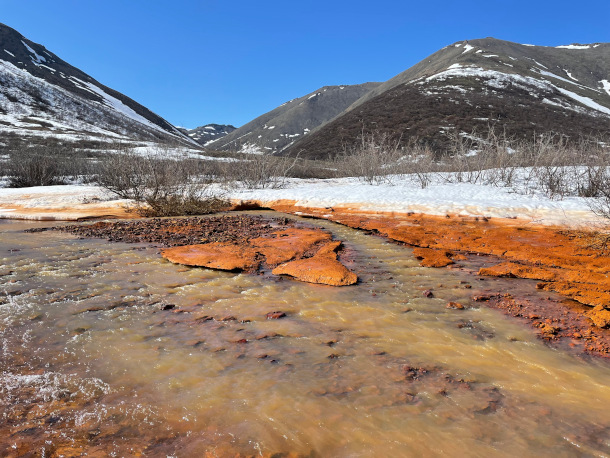
The researchers hypothesize that melting permafrost allows groundwater to flow through mineral deposits, causing chemical weathering. (Photo: Josh Koch, U.S. Geological Survey)
O'DONNELL: Right now we're working to try to determine if these concentrations of metals have exceeded EPA, Environmental Protection Agency, thresholds for both aquatic life and for drinking water. And so we don't have a definitive answer on that yet. At the concentrations, we know that this would affect taste of drinking water, so it might be more metallic. But one of our concerns is that these metals will be accumulated from the base of the food web, through like algae and macroinvertebrates or bugs that live in the bed of the stream, up into fish, you know, similar to what people have shown with like mercury that can bioaccumulate and magnify within a food web, and then it gets into fish and then into people if they eat the fish. So we're concerned because these metals could be toxic both to aquatic life, but into the people that might rely on the fish as part of their diet. And the stream where we were monitoring, and it changed from clear water to orange, when we first went there, and when it was a clear-water stream, it had a really healthy fish population. So lots of small Dolly Varden. And these little resident fish, called slimy sculpin, there was just a lot of them. When we went back after the stream changed color, and it had turned orange, there were no fish. All the fish were gone. We did the exact same protocol for sampling, and the fish had disappeared. And the macroinvertebrate insects, the bugs that reside in the bed of the stream, their numbers declined dramatically with this change. So our thought probably is that the fish migrated out of this river to a better habitat. But there's also a chance that they were impacted by this bioaccumulation of metals up through the food web. And so this was just one instance, where we've measured this, we're continuing our work now to try to figure out really, how are these fish being affected, but our initial thought is that the fish just left, the stream turned orange, and it was not a good habitat for them anymore.
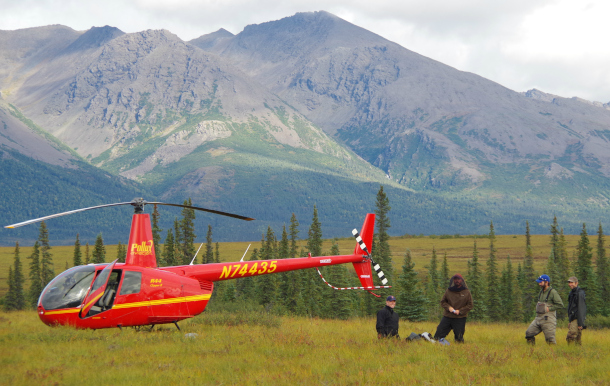
Most areas in Alaska’s Brooks Range are only accessible by boat, small airplane, or helicopter. The team of researchers take a break next to R44 helicopter in Kobuk Valley National Park in 2017. (Photo: Mike Records/USGS)
DOERING: It's amazing how rapidly these changes seem to have happened. I mean, it's, you know, one year to the next, you notice these really rapid, significant changes, which is rare often when we're studying what's happening with climate change. How extensive is this issue in Alaska and beyond?
O'DONNELL: These observations that we have sort of span from the lower Noatak River Basin, in the West, all the way to the Arctic National Wildlife Refuge in the East. So it's, you know, over 1,000 kilometers. We've also been getting reports of observations from other areas in Alaska. So the North Slope, north of the Brooks Range, the Yukon River Basin to the south. So these are all watersheds and regions that are in permafrost zones. And so it's possible that permafrost thaw is driving these observations elsewhere. There is some evidence in the literature for this kind of thing to be happening in non-permafrost regions, such as in the Alps, and in the Andes, in South America, where you have mountain glaciers, and when these glaciers melt, you expose minerals and rocks. And so similar process, except in these other regions, we're talking about glaciers melting, as opposed to permafrost thawing.
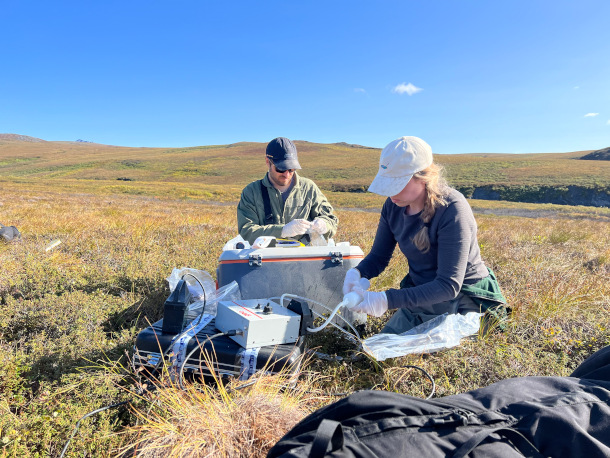
Brett Poulin, Assistant Professor of Environmental Toxicology at UC Davis, and Taylor Evinger, graduate student at the Poulin Lab, UC Davis, process water samples from an upland orange stream in Noatak National Preserve (Photo: Jon O'Donnell/NPS)
DOERING: You know, this era that we're living in is often called the Anthropocene, the age that's shaped by humans. And it sounds like in this case, we're changing geological processes. I mean, climate change is changing so many different geological processes, but it's even changing the way that minerals are coming out of the soil.
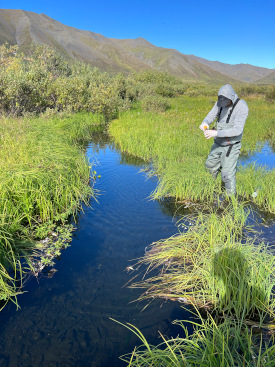
Brett Poulin collecting a water sample from a small stream in Noatak National Preserve. (Photo: Jon O'Donnell/NPS)
O'DONNELL: Yeah, and I would say that the Arctic, because it's so remote, and because of some of the unique features of the Arctic, it's changing at a faster pace than other regions, like temperate and tropical regions and the globe as a whole. You know, I think the latest evidence shows that the Arctic is warming about four times faster than the Earth as a whole. And because of that, and because of the permafrost, and because of how much carbon and other things are stored in the soils up here, there's potential for really rapid change, and really dramatic alteration of ecosystems up here that you don't necessarily see in other parts of the planet. And so yes, the fact that there are these anthropogenic warming effects that are driving climate change in the Arctic, and permafrost thaw, and ultimately, this release of mineral compounds, trace metals into streams, that's a really unique set of factors that we wouldn't necessarily have foreseen when thinking about climate change in the Arctic.
DOERING: Jon, what is it like to be studying this and seeing these changes as a scientist?
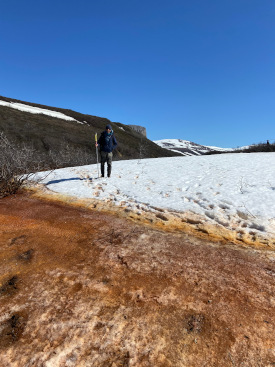
Josh Koch, Research Hydrologist for the US Geological Survey, off to measure discharge (flow rate) at an orange stream. (Photo: Mike Carey/USGS)
O'DONNELL: Yeah, so I've been working in Alaska now for over 20 years. And I view my job as an ecologist, is basically to document the changes that are occurring. And I've worked on a number of different types of studies related to wildfire, permafrost thaw, and carbon cycling, things like that in the Arctic. This is by far the most surprising set of observations that I've been a part of in my time up here. And I think that it is shocking in terms of how fast it's happening and the spatial scale at which it's happening. As somebody who has documented these changes for over 20 years, I've become somewhat used to or maybe desensitized from some of the more dramatic things going on. When I sent this paper to my parents who live on the East Coast in Philadelphia, they responded by saying that they were depressed and saddened by what they were seeing. And because I'm so used to just functioning as a scientist, I maybe separate my emotional responses from some of these dramatic things that are happening up here. But talking to the public and talking to my family and friends, I've kind of been forced to realize that there's this emotional response that people have to wilderness and to nature, and to places like national parks that people love to go and visit, and when they see them undergoing this sort of change, it's upsetting.
DOERING: Jon O'Donnell is an ecologist for the Arctic Inventory and Monitoring Network at the National Park Service. Thank you so much, Jon.
O'DONNELL: Thanks so much for having me.
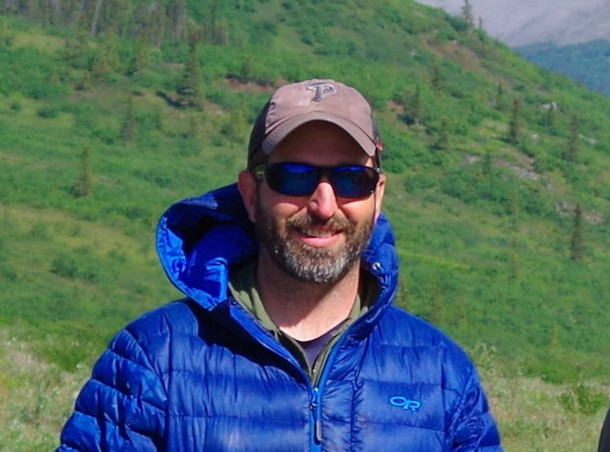
Dr. Jon O’Donnell is an ecologist for the NPS’ Arctic Inventory and Monitoring Network and the lead author of the paper. (Photo: Mike Records/USGS)
Links
Living on Earth wants to hear from you!
Living on Earth
62 Calef Highway, Suite 212
Lee, NH 03861
Telephone: 617-287-4121
E-mail: comments@loe.org
Newsletter [Click here]
Donate to Living on Earth!
Living on Earth is an independent media program and relies entirely on contributions from listeners and institutions supporting public service. Please donate now to preserve an independent environmental voice.
NewsletterLiving on Earth offers a weekly delivery of the show's rundown to your mailbox. Sign up for our newsletter today!
 Sailors For The Sea: Be the change you want to sea.
Sailors For The Sea: Be the change you want to sea.
 The Grantham Foundation for the Protection of the Environment: Committed to protecting and improving the health of the global environment.
The Grantham Foundation for the Protection of the Environment: Committed to protecting and improving the health of the global environment.
 Contribute to Living on Earth and receive, as our gift to you, an archival print of one of Mark Seth Lender's extraordinary wildlife photographs. Follow the link to see Mark's current collection of photographs.
Contribute to Living on Earth and receive, as our gift to you, an archival print of one of Mark Seth Lender's extraordinary wildlife photographs. Follow the link to see Mark's current collection of photographs.
 Buy a signed copy of Mark Seth Lender's book Smeagull the Seagull & support Living on Earth
Buy a signed copy of Mark Seth Lender's book Smeagull the Seagull & support Living on Earth

